|

6-th, 2001 - 23: 2
from
TheHollowEarthInsider Website
Background
A few years ago I spent a great deal of time researching the Arctic
and Antarctic exploits of Rear Admiral Richard E. Byrd looking for
anything that could explain why his name continues to pop up in any
serious study of the Hollow Earth Theory.
I have already reported in
my research about the possible involvement of the Admiral in the
exploration of lands located inside our global world. The most
significant fact is the lack of proof otherwise that really stands
out in our investigation.
In the series of reports, "The Quest for the Inner Passage," (THEI
Vol. 1) we found that Admiral Byrd, who's family is part of the
elitist crowd through kinship with England's Royal family.
Seemed to
know from an early age that he was destined to explore the earth's
Polar Regions. As a matter of fact his grandmother, when the Admiral
was but a small boy, said, "That Child will go to the North Pole
Someday." Could young "Dick' as his family called him, have been
groomed from an early age to explore the secret lands?
In "Quest for the Inner Passage"
we learned that a veil of secrecy has covered his expeditions from
the start. As one biographer put it, "there were secrets that would
not be talked about. (1)
We also learned that
the One World Order paymaster
John D.
Rockefeller and his pals had financed every one of his early
explorations. (2)
And, much to the dismay
of the other expedition members, all of the scientific information
gathered by the members of Byrd's First Antarctic Expedition - "enough to fill 7 large books"
- was turned
over to Rockefeller before anyone else had a chance to study the
findings, only to vanish and never be seen again.
(3)
First Deutsche Antarktische Expedition
In early 1938 those in the know were well aware that a war was on
the horizon in Europe. The German leader Adolf Hitler was beginning
to flex his muscles as he launched a massive expansion of Germany's
borders.
On September 23rd Charles A. Lindbergh, who had been living
abroad since the kidnapping and murder of his infant son in 1932,
wrote a letter to the United States Ambassador to Britain, Joseph
Kennedy, in which he stated:
"I am convinced that
it is wiser to permit Germany eastward expansion than to throw
England and France, unprepared into a war at this time. Britain
cannot win a war in Europe even with U.S. aid."
(4)
Germany had been bankrupt since 1931 and their trade balance showed
a trade deficit of 432 million marks (5) and expansion and buildup
of war materials was putting additional strain on Hitler's
pocketbook.
The financial woes were all pushed aside to finance an
expensive expedition that was then in the planning stages. An
expedition that was important to the Nazi hierarchy for reasons
which has been kept secret till this very day.
On a winter night in 1938 the German research ship "Schwabenland"
cast off from a dock in Hamburg - destination Antarctica. Aboard,
accompanying the ships hand picked crew, was some of Germany's top
airmen, technicians, oceanographers, biologists, meteorologist and
earth scientists, all members of the First Deutsche Antarktische
Expedition of 1938-1939.
The people who made up the costly Antarctic
expedition were under secret orders not to divulge their mission,
the purpose of which little is known today.
(6)
Enter Admiral Richard E. Byrd
On Saturday July 8th, 1939 Americans across the country opened their
morning newspaper to a front-page story not unlike the one from The
New York Times Quoted below.
President Directs
Speed on Byrd Trip
(Excerpts)
"WASHINGTON, July 7 --- President Roosevelt moved today to prevent
possible extension of Germany's claims to Antarctic areas into the
Western Hemisphere by directing Real Admiral Richard E. Byrd to
leave in October to territory within the sphere of influence of the
Monroe Doctrine … it [is] apparent that this government was prepared
to take the position, if necessary, that any attempts by foreign
powers to establish bases west of the 180th meridian in the
Antarctic would be considered an unfriendly act …
If the $340,000
appropriated by Congress for the expedition permitted, Admiral
Byrd said, he would outfit three ships. His own ship would be
The Bear of Oakland, which is undergoing a careful inspection at
Boston. He said he would lend it to the government after a new
engine had been installed…"
As we can see from the above a major confrontation between American
and German forces seemed to be a very real and present danger in
Antarctica in 1939. However, in retrospect we find that, though the
German presence in the "land of everlasting mystery" was the
publicized reason for Admiral Byrd's hurry-up expedition, at no time
did Admiral Byrd or those under his command make any attempt to
observe what the German expedition was up to.
In fact a look at the
map on page 111 of Cristof Friedrich's well documented study of the
German expedition, "Germany's Antarctic Claim: Secret Nazi Polar
Expeditions" will show that neither in the 1938 - 39 nor the
subsequent 1947 and 1955 expeditions to Antarctica did the Americans
come anywhere close to the lands claimed by the Germans.
Could the
stated reason for the 1939 expedition, as is often the case in
military operations, only a cover for a more "important" secret
mission for Admiral Byrd and his fellow members of the 1939
expedition.
The following small article hidden away on a back page
of the November 30th, 1939 issue of The New York Times highlights
that possibility.
Secret Orders Taken
by Byrd on Polar Trip
(Excerpts)
"WASHINGTON, Nov. 29 (AP) - Rear Admiral Richard E. Byrd
joined the vanguard of his South Pole expedition at the Panama
Canal today with confidential orders from the White House.
Officials say the Orders were a State Department secret … Even
the existence of the orders, authorities said, had been kept
secret … Admiral Byrd received them, informants say, on a
hurried trip to Washington last week before departing for
Panama."
Is it possible that these
"secret orders" contained the real reason
for Admiral Byrd's expedition?
And was the fact that the Germans
were also conducting a "secret" expedition in Antarctica make the
Admiral's real reason for putting together the American expedition a
matter of up-most importance? Could both expeditions have been
carrying secret orders to explore unknown "lands beyond the pole?"
Were the Americans and Germans involved, in 1939, in a race to be
the first to gain entrance, and explore the legendary lands inside
our earth?
A race not unlike the ‘space race' between America and
Russia several decades later. In an upcoming issue we will closer at
this possibility, but for now let's look at another mystery.
As I stated in THEI, Volume 1 if you are going to explore unknown
lands for the first thing you must have is a base camp, or "Last
Outpost," on the edge of the area you wish to explore. Here you
would pitch your radio tent so the exploring teams could keep in
contact. You would also use your base camp as the supply dump for
the expedition. In January of 1929 Admiral Byrd established "Little
America" as that outpost on the Antarctic continent.
But what if the area to be explored wasn't a barren land of ice and
snow? What if it were more supportive of life than we are told - such as unknown, thought-to-be extinct huge wild animals and
reptiles, and even more dangerous, creatures of intelligence equal
or greater than mans? In that case the best piece of equipment to
have would be some sort of mobile base.
One that would enable your
expedition crews a way to cover a lot of territory very quickly, and
at the same time, be a haven of relative safety for the
adventuresome explorers.
The Mysterious Snow Cruiser
Front-page story of July 8th 1939, The New York Times:
Snow Cruiser Offered
by The Associated Press
WASHINGTON, July 7
A giant "Snow Cruiser" specially designed to
span yawning crevasses and jagged ice ridges, may be a major piece
of equipment on the Byrd expedition. The cruiser was designed by Dr.
Thomas C. Pouiter of Chicago, second-in-command of the Byrd
expedition in 1933-35.
" In recent testimony before a House appropriations subcommittee he
indicated that the odd craft could carry sufficient equipment for an
exploring party to last a year.
" On it's deck, Dr. Pouiter
suggested, the machine could carry a Navy pursuit plane, which
by making short flights at 300-mile intervals, could explore
about 5,000 square miles of unknown territory during a single
Antarctic summer."
Snow Cruiser On Its First Lap
Airplane That Will Accompany The Cruiser
Let's stop and let that sink in.
"Sufficient equipment for an
exploring party to last a year!" Could explore 5 hundred thousand
miles of unknown territory …
That's a lot of ice and snow to say the
least. Put into perspective that is equal to one hundred auto trips
from Anchorage Alaska to Jacksonville Florida! Someone was planning
an expedition that, in its time, seems to rival man's first trip to
the moon.
Naturally something of this magnitude was destined to
capture the interest of the press and the citizens of America, so
the step by step development of this "snow cruiser" was followed
eagerly by the media of the day.
From the July 15th 1939 issue of
The New York Times:
Byrd to Use Army
Tanks on Polar Quest
Big Snow Cruiser in Antarctic Equipment
by The Associated Press
(Excerpts).
"BOSTON, July 14 - Rear Admiral Richard E. Byrd disclosed plans for
his coming expedition in the Antarctic said today that 6 army tanks
and a unique 45,000 pound snow cruiser would be used for transport
over the South Pole's icy wastelands …
The snow cruiser … would carry four men and a plane, and would
be extremely mobile and easy to manipulate under the difficult
conditions found in Antarctica…"
I found the next significant mention of the
"snow cruiser" in the
August 2, 1939 issue of The New York Times in, of all places, The
Society Section:
Giant Tire Soon ReadyMade in Akron for Antarctic Trip
It Will Weigh 1,900 Pounds
"CHICAGO, Aug. 1 (AP)
- The Armor Institute of Technology said today
that the first of the giant tires for the ice cruiser of the
government's coming Arctic expedition would be taken from it's mold
at the Goodyear Tire and Rubber Company's plant at Akron Aug. 9.
"Harold Vagtborg, director of the Armor Foundation, said
the 10-foot tire, each weighing 1,900 pounds, will be the
largest ever manufactured…"
Not to be outdone many of the nationally read popular magazines of
the time also ran their own stories, complete with drawings and
diagrams of the giant vehicle. Scientific American ran their story
in the January 1940 issue.
However they were beaten
to the punch by Popular Mechanics whose story "Snow Cruiser to Explore Antarctic"
was featured in their October 1939 issue. According to their report
the huge monster vehicle designed to "climb the polar mountains and
slither across giant crevasses" would be fifty-five feet long and
fifteen feet wide.
The power would be supplied by two 200-hp diesel engines that would
be connected to generators to "furnish power for driving, for radio,
electronic stoves, heat and the machine shop." The giant cruiser
would be controlled by one man who would be in the "second floor"
cabin.
The Popular Mechanics article continued to describe the
vehicle.
"Below [the driver] is the repair shop; to the rear, navigation
chart desk, galley which is also photographic darkroom, bunkroom,
storeroom and a compartment in the tail for two spare tires …
The
cruiser will have a 5,000-mile range, and will travel at from ten to
thirty miles an hour under any conditions except severe blizzards.
An automatic gyropilot may be installed to hold the cruiser on any
course set. Front and rear wheels steer independently so that the
Antarctic bus can turn in a thirty-degree radius or shift sideways
at a twenty-five degree angle.
The scientists will measure thickness
of the ice with the geophysical seismograph, make gravity
determinations and meteorological observations, survey unexplored
Antarctica and study the Aurora, Terrestrial magnetism, meteors and
other phenomena. Cruiser and equipment will cost $150,000." [1939
Dollars]
The Popular Mechanics article also reported that the Navy BI-plane
which "carried a seven-inch lens mapping camera," was rigged atop
the cruiser in such a way as to be "hauled to its perch by winch or
launched on the snow in ten minutes."
As the planners moved full-bore ahead with their plans the public
was taken along for the trip through the pages of newspapers across
the nation.
On October 15th the New York Times ran a picture of the
partially completed cruiser along with an article titled:
Byrd Expedition Gets Polar Gear
Two ships and 125 Men, 160 Dogs and
5,000 Varied Items are going to Antarctic
Five Planes To Be Taken
3 Tanks and a Snowmobile Are to Aid Work
- Departure Set for Early Next Month
"BOSTON, Oct. 14 (UP)
- The greatest Antarctic expedition in history
-- both in numbers and accessories - is being assembled here for
what may be a tortoise-like race with Nazi scientists for minerally
rich south polar areas.
"A century after the first United States Antarctic expedition, this
second government-financed group will be directed by Real Admiral
Richard E. Byrd, who twice in the last decade has led his own
expeditions into the land where nights are four months long.
"Delayed a month, the expedition hopes to leave Nov. 1,
reaching its destination when harbors are ice-free and if
possible ahead of parties reportedly organizing in Germany
and other countries."
Once finished the snow cruiser was driven from the factory in
Chicago to the dock in Boston supported by a police escort that
halted traffic along the highways in 20-mile stretches so the huge
machine could pass.
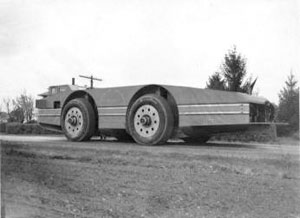 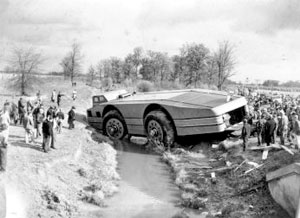
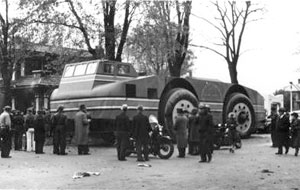 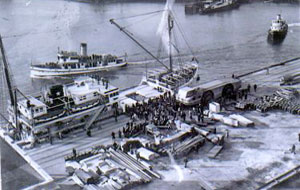
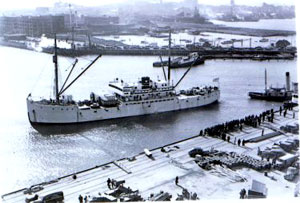 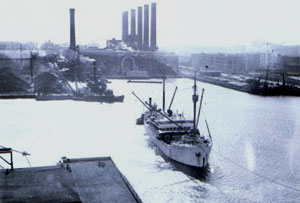
Thousands of people followed its progress in
newspaper articles and radio reports. Many stopped along the route,
or made a special trip, to try and catch a glimpse of the giant
machine.
By October 28, 1939 the cruiser was well on its way to
Boston, but not without mishap.
From the October 29th, 1939 issue of
The New York Times came the following report.
Byrd Snow Craft Founders in Creek
35-ton 60-Fool Cruiser Hits an Ohio Bridge and Plunges off Road into
Water
(Excerpts)
"Lima, Ohio, Oct.
28 (UP) - The giant snow cruiser … struck a bridge near
Gomer, about 10 miles from here and stumbled into a stream …
The machine drove its nose several feet below the surface of
the water while the rest of it was left spanning the stream
… it [will] be several days before the huge machine could be
raised from Pine Run Creek and the trip resumed…"
Everywhere it traveled the strange-looking vehicle made headlines.
The New York Times, November 1939,
Byrd's Snow Cruiser Startles Bay Traffic
Snarls Traffic in Crawling over
The Berkshires
Special to The New York Times
"Boston, Mass.
Nov, 13 - The Antarctic snow cruiser, most tenacious road
hog ever to invade New England, steering a leisurely,
bouncing course today over the Berkshires from Pittsfield to
Framingtom, caused the greatest traffic jam in Massachusetts
history…"
One letter to the editor, obviously from someone who had been caught
up in the movement of the huge craft halfway across America,
published in the November 14th 1939, The New York Times stated that
the snow cruiser "is a thing that has to be seen to be believed.
Once seen, it makes one happy as well as proud to know that
it soon will be traveling the Antarctic Continent, where it
can not hold up 70,000 motor cars and create a 90-mile
traffic jam, as it did in Massachusetts on Sunday."
Then on November 15th 1939 The New York Times headline many had been
waiting for:
Cruiser Aboard, Byrd Ship To Sail
Snowmobile is lashed to deck
And North Star Prepares to
Leave Boston at Dawn Today
SETTLEMENTS PROJECTED
Expedition Chief Proposes Ice
Habitation for 5 or 6 Years
To Clinch Discovery Claims
In January 1940, as reported in the January 19th issue of The New
York Times, the closely watched, well-documented machine arrived in
Antarctica:
Byrd Cruiser in Antarctic Crash
‘Bouncing Betty' Narrowly
Escapes Disaster Leaving
Ship in Bay of Whales
Special to The New York Times
(Excerpts)
"Washington, Jan 18
- A narrow escape from disaster in moving the
Byrd Antarctic snow cruiser from the ship to the ice at the
expeditions landing place in the Bay of Whales…
"Amid a welter of flying splinters and broken planks, the gigantic
snow cruiser lumbered safely ashore tonight from the Antarctic
Service ship North Star. The cruiser … Kept on the move once all
four of her ten-foot wheels reached treacherous bay ice alongside
the ship.
Remaining at the
controls, Dr. Thomas C. Pouiter of Chicago drove her a full
mile from the ship before coming to a halt…"
As we can see from the above documentation,
the Snow Cruiser was the
star of Admiral Byrd's 1939 Antarctic Expedition.
For months
Americans had read every tiny detail about the progress of
manufacturing the beast. The delivery was like the coming of the
circus parade and those close enough, or lucky enough, to travel to
the publicized route lined the highways as the celebrated vehicle
passed by. In fact the snow machine was featured in every newspaper
headline concerning the preparations for the 1939 Antarctic
Expedition.
But after the ‘outpost on wheels' was reported to have
made it safely to the Mysterious Continent … the mystery begins…
From this point on the snow cruiser was never mentioned again. I
have spent many, many hours searching through back issues of
newspaper and magazine indexes after that final report. Nothing.
Once again, as with every investigation into Admiral Byrd's
shenanigans in the Polar Regions of our globe, a lead I was
following had vanished like a puff of smoke. It was as though the
snow cruiser never existed. What happened to the monster machine and
the data it was designed to gather? Could it and a handpicked crew,
once unloaded, have gone off on a mission of their own? A mission so
secret that it has not been talked about even to this day.
Our final newspaper article might hold a couple of clues. The May
15th issue of The New York Times carried a lengthy article detailing
Admiral Byrd's report on the findings of the 1939 United States
Antarctic Service Expedition. The Admiral reported that the
expedition "achieved much more than he thought possible including
the discovery of 900 miles of unknown coastline that explorers had
been seeking for a hundred years.
In the lengthy interview he never mentioned the snow cruiser. Even
stranger, was that apparently he was never asked. The giant machine
that had been on everyone's minds and lips before Byrd left was
might never had existed. He did tell us that 59 men were left behind
to carry on.
Were these brave souls the crew and support team for a
secret mission using the mighty cruiser to explore "the lands beyond
the poles?"
The article also tells us that,
"The Admiral emphasized the fact that
this was not "another Byrd expedition" but a project sponsored by
the United States Government … In other words John D.
Rockefeller and his pals didn't foot the bill this time … Uncle
Sam did. He ended the interview with the statement that
henceforth he will direct the expedition from Washington."
Are these small clues pointing towards what many have said all
along? That Admiral Byrd dedicated his life to exploring lands
inside our earth with entrances at the poles.
Is this truly the "Closest Guarded Secret in the World?"
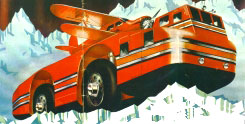 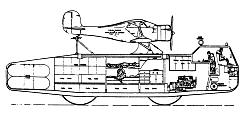
For more information on the Snow Cruiser
go
HERE
|









